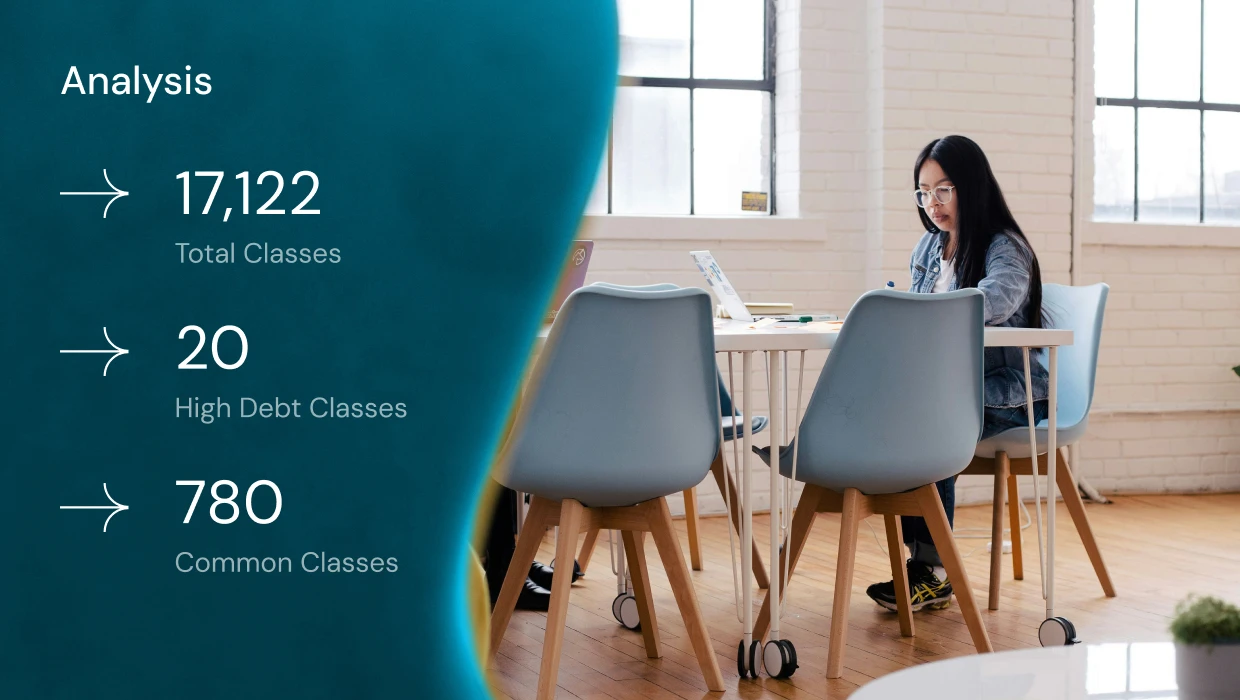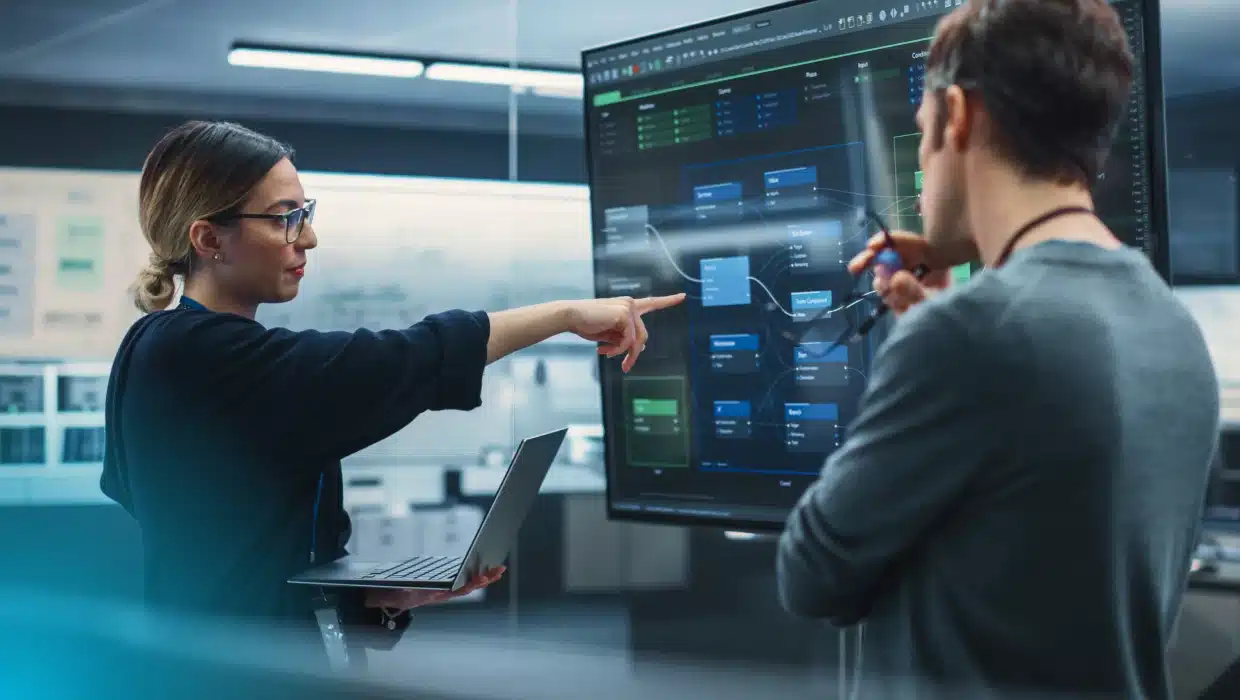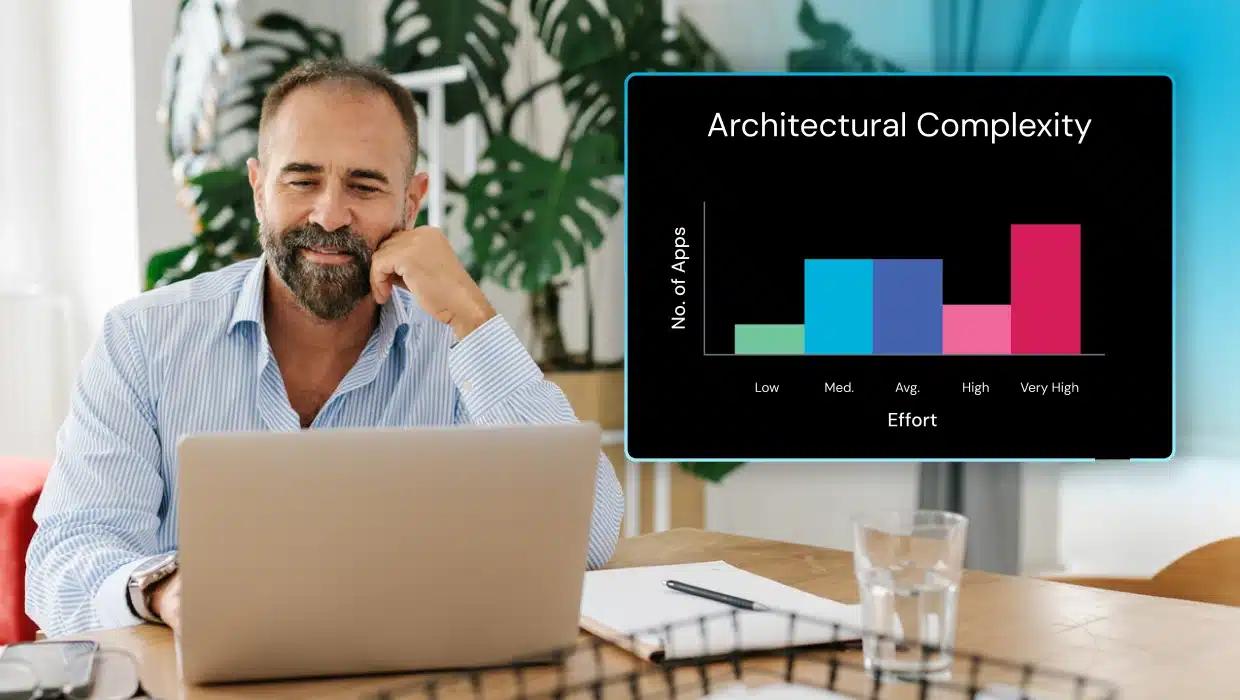The choice to move on from outdated legacy software is by no means a small feat. And yet, in many cases it’s essential. According to a 2022 survey, 79% of IT leaders find themselves held back in their digital transformation processes by outdated technology. Whether you want to move to modularized versions of monoliths or microservices, the best time to start is now. The migration process begins with assessing your existing architecture as the starting point for transformation. If you decide that cloud-based microservices is best for your organization, here’s how you can transform your monoliths into microservices.
Building a better software architecture comes with a wide range of benefits, from more efficient software builds and functionality to easing the strain on your technical personnel. But it cannot happen automatically. The process typically involves moving from a monolithic architecture to a microservices-based approach.
Instead, you need a strategic and comprehensive process that addresses how to transform monoliths to microservices. Initial planning is crucial before starting the transformation, as it helps establish migration patterns and strategies for a successful transition. That process, in turn, relies in large part on the right tools to help you succeed.
So let’s get started. In this guide, we’ll cover both the basics of a monolith-to-microservices transformation and the tools that can help with that process — including some tips on how to select a tool specifically designed to help your transformation succeed.
Just the Basics: How to Transform Monoliths to Microservices Architecture
Designed as a solitary, internally focused system, monolith architecture includes everything the user needs—from a database to interfaces. But it also lacks flexibility, which can make microservices a more attractive option for smaller teams moving to more agile alternatives. But of course, unless you’re starting from scratch, you cannot simply turn the page to this more dynamic environment. Instead, you need to know how to transform monoliths to microservices.
Related: Is Refactoring to Microservices the Key to Scalability?
While the nuances of that process go beyond the scope of this guide, it bears mentioning just what steps are involved in it—and where the right tools to deliver that transformation enter the equation.
- Assess your current software architecture. While it can be difficult to dig to the bottom of years-old monoliths, architectural observability can play a key role in this step.
- Determine your migration approach. There are several routes you can take here. Familiarize yourself with the Seven R’s of Cloud Migration—your approach will also determine what tools you need.
- Establish continuous modernization. A successful migration from monolith to microservices is not a one-time effort. Instead, it’s only the start of an ongoing effort to keep optimizing your architecture over time.
Each of these steps takes significant time, expertise, and strategy. Each of them, though, can be improved and streamlined with the right tools.
Domain-Driven Design: Laying the Foundation for Microservices
Domain-Driven Design (DDD) is a foundational approach when transitioning from a monolithic system to a microservices architecture. By focusing on the core business domain and its underlying logic, DDD enables teams to break down complex applications into well-defined, manageable components. Through the creation of a domain model, developers can map out the essential entities, value objects, and aggregates that represent the heart of the business. This model not only clarifies the business logic but also guides the decomposition of the monolithic system into independent microservices, each responsible for a specific business capability.
Applying domain driven design ensures that each microservice is closely aligned with the business domain, reducing unnecessary dependencies and making the architecture more adaptable to change. DDD also fosters a common language among developers, architects, and business stakeholders, streamlining collaboration and ensuring that the microservices architecture remains in sync with evolving business goals. By laying this groundwork, organizations can create a robust, scalable, and maintainable microservices architecture that genuinely reflects their business priorities.
Four Types of Tools You’ll Need to Ease the Monolith to Microservices Transformation
Across industries, a number of tools have established processes that can help with the transition from a monolith architecture to microservices. Each of them covers different areas of the process, ultimately working together to help you build a successful transformation process.
1. Architectural Observability Tools
Architectural observability is a crucial first step in any microservices transformation. As mentioned above, it allows you to get a full picture of the current monolith to be transformed, which establishes the baseline and steps you need to take. Especially for complex platforms, that process can be immensely cumbersome—until you find the right tool for it.
Observability tools are centralized platforms that visualize the data streaming from your application. Based on that data, you can better understand the nature of the software, including anything from its behavior to the infrastructure that led to the data delivery to begin with.
Unlike APM and observability tools that focus on understanding metrics, logs, and traces, architectural observability focuses on the foundational pieces of your software. With the right tools, you will be able to incrementally identify and address architectural drift while also managing the accumulation of architectural components, decisions, and drift that can make monoliths so difficult to manage.
The right tools for architectural observability can help establish the foundation for how to transform monoliths to microservices. Only full observability allows you to understand just where—and how—you can begin your transformation process.
2. Software Replatforming Tools
Replatforming is the process of taking legacy software and shifting it to a cloud environment. But it’s not just a one-to-one replacement; instead, some modifications are made to optimize the platform. While not a true transformation from monolith to microservices, some of these modifications can still move your architecture in the right direction. Replatforming can also lay the groundwork for continuous deployment by modernizing the underlying infrastructure, making it easier to adopt rapid and independent deployment cycles in the future.
You’ll find a plethora of tools that help with this process. For example, Azure Migrate is a Microsoft service designed to move your software to the Azure platform, with optimization steps included in the process. AWS Application Migration and Google Cloud Migration Tools achieve a similar goal.
Related: The Best Java Monolith Migration Tools
Each of these tools, of course, is optimized to migrate your architecture to the cloud system to which they’re attached. In their goal of streamlining that migration, they offer some optimization, but the process still falls short of a complete monolith to microservices transformation—which is where refactoring tools enter the equation.
3. Software Refactoring Tools
Among the Seven R’s of Cloud Migration, refactoring offers the best mix of streamlining the migration and creating a true transformation from monolith to microservices. It focuses on changing the fundamental code of your application—without changing its core functionality. This process can quickly become resource-intensive, and it can also increase code complexity, making it essential to manage and monitor the system carefully. Refactoring tools can make it a more realistic and efficient option.
The right refactoring tools will take on multiple dimensions. The process begins with dynamic observations that track exactly how the current architecture operates, which then identifies the ways in which a monolith can split into multiple microservices. It all happens dynamically, maximizing the accuracy of the analysis to avoid potential pitfalls or blind spots static analytics might miss.
And that’s just the beginning. The right tool takes that analysis and begins to split up services while minimizing dependencies. When planning migration strategies, it’s crucial to consider both reversible and irreversible decisions, as reversible decisions enable easier risk management and correction of mistakes. Much of that migration to a more modern framework can happen automatically and with minimal manual inputs required. Engineering teams can instead focus on testing the newly created microservices to ensure the new and modified source code functions as well as and better than the monolith it replaces. In this context, implementing a fallback mechanism is crucial to enable safe rollbacks to the previous version if issues are detected with the new microservices.
4. Continuous Modernization Tools
Finally, it’s crucial to acknowledge the fact that microservices, unlike monoliths, are not static. Their distributed nature often means they run across multiple machines, which introduces unique management and debugging challenges. Instead, they are at their best when continually optimized and modernized to keep improving efficiency and productivity for the business.
That, in turn, means finding a tool that can help take an iterative approach to app modernization. It needs to account for release cycles and sprints, along with insights taken from ongoing architectural observability, that underlie the analysis of where modernization continues to be beneficial. During this process, it’s important to use tools that can synchronize data across services, ensuring data consistency and reducing downtime as you modernize.
Look for tools that offer self-service modernization options. The right tool can help you continually track your inefficiencies and architectural tech debt, which in turn creates a roadmap for where you can continue to improve. Connect it with your refactoring tool, and you get a modernization engine designed to keep optimization and efficiency at the forefront of all your software engineering and operations.
Database Decomposition: Breaking Up the Monolith’s Data Layer
One of the most challenging aspects of migrating from a monolithic system to microservices architecture is decomposing the data layer. In a monolithic application, the database is often a single, tightly coupled entity, making it challenging to perform application and database decomposition without risking data integrity. However, leveraging proven database decomposition patterns—such as the database wrapping service pattern—can help organizations break up the monolith’s data layer into smaller, service-aligned databases.
The database wrapping service pattern acts as an intermediary, allowing new microservices to interact with the existing monolithic database through a well-defined interface. This approach helps maintain both referential and transactional integrity during the migration, ensuring that data remains consistent and reliable across the entire system. As each microservice gradually takes ownership of its data, dependencies between services are reduced, and the risk of breaking referential or transactional integrity is minimized. Ultimately, database decomposition empowers each microservice to manage its data lifecycle, paving the way for a more resilient and scalable microservices architecture.
Pattern Spotlight: Strangler Fig Applications for Incremental Migration
Although multiple migration patterns can be helpful in the process, the Strangler Fig application pattern offers a proven method for incremental migration from a monolithic system to microservices architecture. Rather than attempting a risky, all-at-once migration, this pattern allows organizations to build new microservices alongside the existing monolithic system. Over time, new functionality is routed to the microservices, while legacy components are gradually retired. In short, the implementation generally looks like this:
- Identify the legacy component to be replaced (e.g., service, module, or endpoint)
- Isolate functionality using a facade, proxy, or API gateway
- Implement new functionality alongside the legacy system
- Gradually route traffic to the new implementation
- Incrementally replace legacy features with modern equivalents
- Remove legacy code once it’s fully deprecated and unused
This approach is especially valuable for legacy systems where a complete rewrite is impractical or too disruptive. By enabling incremental migration, the Strangler Fig pattern allows teams to maintain business as usual while steadily introducing new, modernized components. This reduces the risk of downtime and provides opportunities to test and validate new microservices in production before fully decommissioning the monolith. For organizations seeking a low-risk, flexible path to microservices architecture, the Strangler Fig pattern is an insightful migration pattern that supports continuous improvement and adaptation.
Managing Distributed Transactions: Sagas and Saga Rollbacks
As organizations adopt microservices architecture, managing distributed transactions across multiple services becomes a critical challenge. Traditional monolithic systems often rely on single, atomic transactions, but in a distributed environment, this approach is no longer feasible. The saga pattern provides a tested solution for coordinating distributed transactions, allowing each service to execute its part of a business process independently while maintaining overall consistency.
A saga is composed of a series of local transactions, each managed by a different microservice. If any step in the saga fails, saga rollbacks are triggered, executing compensating actions to undo the changes made by previous steps. This ensures that the system can recover gracefully from failures, maintaining data integrity without relying on complex distributed transactions. By implementing sagas and robust rollback mechanisms, organizations can build resilient, fault-tolerant microservice architectures that handle failures gracefully and keep business processes running smoothly across multiple services.
Security Considerations in Microservices Transformation
Security is paramount when transforming a monolithic system into a microservices architecture. Unlike monolithic applications, where security controls are often centralized, microservices require each service to implement its own security measures, including authentication, authorization, and secure communication protocols. This distributed approach introduces new challenges, such as managing credentials across multiple services and ensuring that data exchanged between services is encrypted and protected from unauthorized access.
Organizations must also address the unique risks associated with distributed systems, such as increased attack surfaces and the potential for lateral movement by malicious actors. Adopting security best practices—like using strong encryption, implementing service-to-service authentication, and regularly auditing access controls—helps safeguard sensitive data and maintain compliance. By prioritizing security throughout the migration process, organizations can ensure that their new microservices architecture is not only agile and scalable but also robust against evolving cyber threats.
How to Select the Right Tool to Transform a Monolith to Microservices
For each of the categories mentioned above, you will find multiple tools that claim to help you in the process. Selecting the right one, as a result, can be surprisingly challenging. A few tips can help:
- Look for tools that prioritize refactoring over simpler alternatives like replatforming. It’s the only way to ensure that your outcome is a truly agile and future-focused software architecture.
- Look for tools that can combine at least some of the functions above. A refactoring tool will be helpful on its own, but that helpfulness gets magnified when it also integrates with your architectural observability and continuous modernization engine.
- Look for tools with an established track record. Case studies and references can help you understand whether the claims made on the website or in an exploratory call can be backed up with real-world successes. Tools that provide numerous illustrative examples are especially valuable, as they clarify complex migration processes and strategies.
- Look for tools with intuitive user interfaces to ensure ease of use and adoption by your team.
- Consider advanced tool capabilities, such as a mapping engine, support for database views and the database view pattern, handling split table scenarios, managing foreign key relationships, working with a shared database, supporting newly extracted service transitions, enabling change data capture, and facilitating message interception. These features are crucial for complex migrations and ensuring data integrity.
- When evaluating risk and planning your migration, consider failure modes to ensure reliable process execution.
- Be mindful of the sunk cost fallacy and avoid continuing with ineffective strategies simply because of prior investment.
Ultimately, the right tool can help you understand how to transform monoliths to microservices. Even better, a tool that matches all of the above criteria can significantly streamline the process, saving you time and resources while improving the outcome.
vFunction’s suite of tools, from our Architectural Observability Platform to the Code Copy feature and continuous optimization abilities, can help you get there. Request your demo today to learn how our platform can move your software out of legacy systems and into a modern, future-facing software architecture.






